It’s a glorious July Saturday. The sun is showering this corner of the world with warmth and optimism. The earth’s bounty and human toil, and some craic, surrounds us, and you can hear the stream nearby and the birds in the trees. There is abundance and productivity and nature and community and generosity.
The bucolic scene is in the midst of suburbia, in a small corner of Corkagh Park near the Naas Road in Dublin 22. While beyond its perimeter people stroll or jog, children play and the regular busyness of the large Dublin park gets on with it, within this sheltered haven is the Clondalkin Global Garden Community.
Obviously it’s not always like this; mucky digging in dark, dank November is a different kettle of fish. Still, today it’s summertime, and a large group have just wound up work, finishing with a picnic. They have shared out this week’s harvest – lots of vegetables, some gooseberries and redberries, lavender, bunches of vivid montbretia.
“It’s our main working day, Saturday from 11.30am until nature has been fed and cared for by our community,” says Maeve Murphy, the Global Garden’s volunteer liaison.
READ MORE
The garden was born around 2010 out of an international group at the Intercultural Centre, where Gilbert Storrs and Anne Garvey facilitated conversations, often about gardening, and how many felt disenfranchised from their faraway lands and farming cultures. Organic gardening workshops eventually led to the garden, on land from South Dublin County Council in Corkagh Park. There’s an active committee and facilitation from local development group South Dublin County Partnership.
Debbie McAuley from SDCP explains how community gardens differ from allotments: No one rents the land individually, as they do with allotments. In community gardens, growing is for everyone’s benefit: the labour is shared, as are its fruits. Members plant and tend specific beds (this varies among community gardens). “Everything is for everybody.”
Murphy’s journey into the world of multiculturalism and organic gardening began in 2012.
“We have a better bond with nature and each other. Our mission is to celebrate diversity, inclusion, integration, equality and promote communication through our organic gardening. We’re looking at a sustainability cycle, from seed to seedling to plant to veg or flowers. At the end of the day, all our garden waste is put on to a wall bank, which will compost down and we can eventually plant along it.”
Many members know what they’re doing, ‘and those that don’t learn fast’
At the garden, chairman Kenneth Mtetwa leads the way around the wooden framed beds. He opens the door to the polytunnel and a blast of heat hits. Inside is an unfamiliar spinach-like vegetable, planted by Shahid Ullah from Bangladesh.
Selma Correia is growing “spudatoes, beans, and tomatoes I try. Onions, garlic, peas, celery.” They’ve grown beans, and planted cucumbers very successfully last year, and Polish garlic (“it’s stronger”), red cabbage, sprouts.
“I came from a different country and here I meet a lot of people, a mix of cultures. So at least I’m not lonely in a strange country. We chat, we work a little bit, we talk, a cup of coffee. We became friends. I like to meet people. I’m always doing something. I’m one of the longest members.”
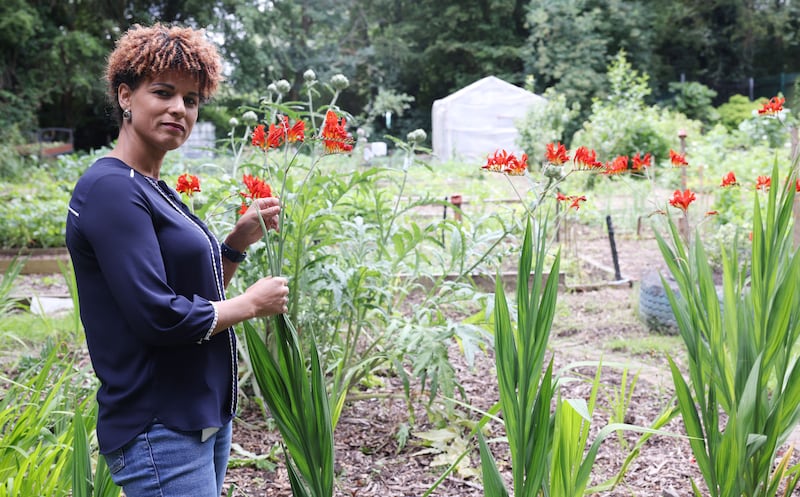
From Mozambique, Correia joined her Polish husband here in 2008 (“I have become Irish already”) and is a member of the garden since 2014. Her father was Portuguese and moved to Mozambique; he was a farmer. “I like plants.” She grows strawberries and tomatoes at home too, but in containers as she’s renting. She was studying and recently started working as IT administrator, so finding time is more difficult now. She comes in the morning sometimes. “I hear the birds. It’s so peaceful. There can be stress at work or at home but when you come to the garden, it is very renovating.”
Ginny Sumy from Clondalkin has “loved gardening all my life. This is only my second year here.” She points out the raised bed where she’s growing saffron, plus “lavender here, and I spend most of me time weeding.” She comes to the garden because “a nicer bunch of people you could not meet, every one of them. They’re friendly, helpful. It’s like a tonic coming down here.”
Kenneth Mtetwa was a farmer in Zimbabwe, where he grew corn and tomatoes and sorghum. “It’s different, this gardening. In Zimbabwe, every time it’s rainy season we get our food.” He enjoys the garden, because “I am always busy. I like to help everybody, I am handy. I am living in Direct Provision since 2017, so for those years to be there not doing anything ...” was hard for him, he says.
Before Covid, he gardened three times a week and grew many vegetables: cabbage, spinach, onions. These days he guides a lot of volunteers, and tends to plant one thing at a time. He’s growing tshomalia now, a leafy vegetable from Zimbabwe, like cabbage or spinach. “Coming here it gives me a peace of mind. And to meet people and to integrate and knowing people from the community. It keeps me ... Yes.”
Coming to the garden helped me reconnect with an inner peace I long used to have before ‘life happened’, long before I came to Ireland
Mtetwa says his wife Simangele Sinbindi is a good cook, and sometimes he shares vegetables with others in Clondalkin Towers direct provision, where they have cooking facilities.
Many members know what they’re doing, “and those that don’t learn fast”. “Like me,” says Debbie McAuley. “I can’t keep a Busy Lizzy alive. I’m only learning. But I know this plant needs to be taken out because it’s strangling the fruit.” (And she does.)
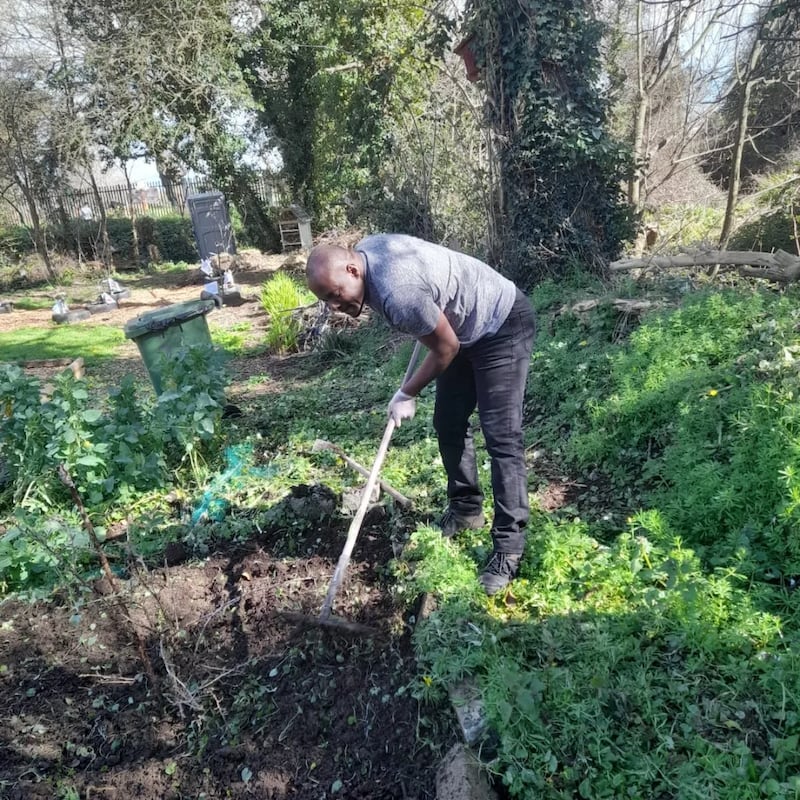
Rasheed Ishmail, Francis Shem, Yusuff Olayiwola and Akinola Adekola-Omode are growing “African vegetables, Irish potatoes, onions”. For them, “It is more than the experience [of growing]. The impact on our life is more than that.” And “We are here to grow a lot of things. We are able to grow African vegetables in the polytunnel because this place is too cold.”
Kassi Mohit’s grandad had a farm in Mauritius, but she wasn’t familiar with farming. “I was only eating what he was growing! Then I came in Ireland 20 years ago.” She’s here “to make friends, meeting people from all round the world, and for the vegetables too”.
Eva Boros picks a leaf of lovage, which we crush and smell. She adds it to soup. It’s popular in Hungary and Romania, her places of origin; she moved to Ireland 15 years ago. Her partner Frank, who’s here today, is blind. “I come every Saturday. I not go anywhere, I come only here in garden, because I’m carer for my partner. I stay at home 24 hours, and here for relax and good community and herb. Everybody is very friendly, Maeve and Anthony and Debbie, here I have a lot of friends.”
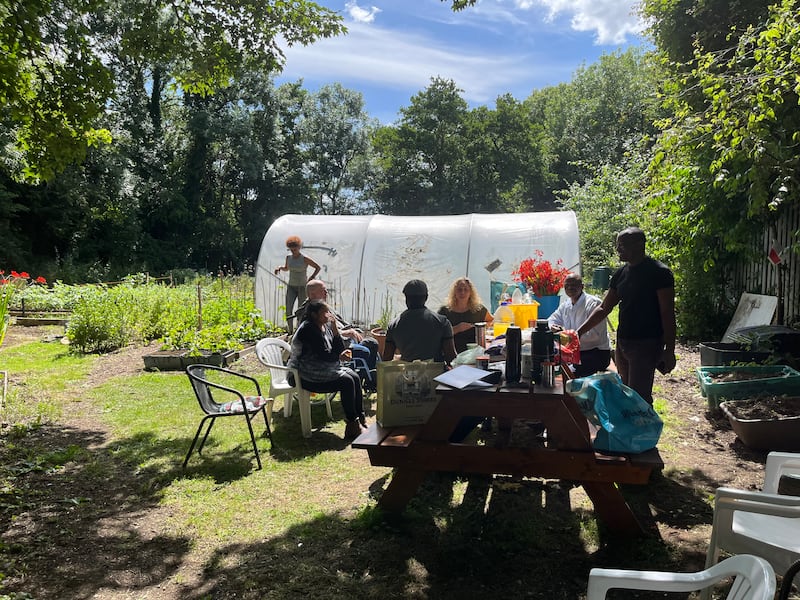
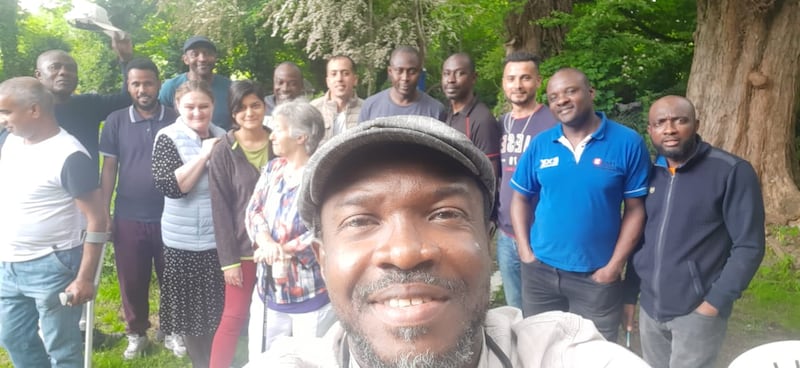
Benedict Chukwurah from Nigeria, who lives in direct provision at the Red Cow Moran Hotel, later says how “coming to the garden helped me reconnect with an inner peace I long used to have before ‘life happened’, long before I came to Ireland. I found warmth, love, understanding and acceptance immediately I walked through the gates of the garden and was introduced to its members. Maeve made me feel welcome and inspired a sense of joint ownership and responsibility for the growth and development of the garden, as well as members.”
He says the garden allows de-stressing through nature baths and friendliness, and a platform for learning about nature, plants and diverse cultures. “It is a networking base for people who have come from far and wide and have found themselves in a completely new environment, distant from their original families and friends. For me, it has provided an additional sense of purpose and will continue to inspire an unwavering commitment for a very long time.”
Mention community gardens or allotments to anyone, and they’ll have a reference point, whether the brother who grows all his veg in his allotment, or the community garden that has changed an area’s social connections. Mick Kelly, founder of Grow It Yourself, the non-profit social enterprise in Waterford, says “community gardens can go beyond bringing people together, and can be transformative for spaces, like the Mud Island Community Garden near Croke Park, which was derelict and a magnet for antisocial behaviour.”
[ How to use cardboard in your garden or allotmentOpens in new window ]
He has observed a surge of interest in food growing generally. During Covid, “it was one of the key things people wanted to do when they had time on their hands. People turned to growing because the foundations of societies are shaky, and it makes people feel a bit more secure maybe.” There was “an absolute explosion of activity in the two years of lockdown, 200 or 300 per cent increase” in website hits and orders from GIY, and it’s still high compared to pre-Covid.
It’s a simple climate action: “Food growing is very accessible, it’s very affordable and people feel it makes a difference to their personal carbon footprint around food, unlike big, expensive projects like electric cars or changing heating systems.” Plus there are immediate benefits for physical and mental health, and for saving money.
Kelly cites Bord Bia research showing 20 per cent of Irish people grow some food themselves, but that about 60 per cent of us want to do so. “There’s a big gap there between people who want to grow, and people who are doing it. Barriers are stopping people, and access to growing space is one of them.”
Lack of knowledge can also be a barrier, which is where GIY operate, and time; we’re all time-poor, and growing requires prioritising time to fit it into your lifestyle, says Kelly. “We would always encourage people to look to their own garden space first, even if it’s very small, before you make the leap into an allotment.”
[ Wild food: Fancy some acorn gruel with your bramble tea and seaweed jelly?Opens in new window ]
GIY has a demo apartment balcony, and a demo suburban back garden where “with three raised beds and a small greenhouse, we produced around 50 kilos of vegetables a year. The average Irish family consumes about 250 kilos of vegetables,” so even a very small set-up makes a difference. For renters, one solution is a vegetable trug, a portable raised bed.
There’s no legislation or Government policy on growing your own food, nor on increasing or protecting community growing, an activity with multiple benefits for sustainability and biodiversity
Kelly grows at home in an allotment-sized space, but cautions “it’s a very hard taskmaster. I prioritise that time because it’s very important to me. But you need to make it manageable. As I’ve got a bit older I’ve scaled back. Ten years ago I was keeping pigs and chickens and I was obsessed with being self-sufficient. That was a bit of a folly to be frank.” Now he’s “growing things I really like, being comfortable that I produce a percentage of my own food myself”.
It’s hard to get a total picture of numbers of allotments and community gardens in Ireland. Once, during the Emergency, Ireland had 30,000 allotments, but now provision is low and unevenly distributed. A 2020 Local Government Management Agency report indicates 2,500 council allotments and community gardens across 31 local authority areas, but eight provide no allotments or community gardens at all. There are also privately-owned community growing spaces.
Other European countries offer far more community growing spaces, says Dónal McCormack, chair of Community Gardens Ireland (CGI); Germany, for example, has 1.3 million plots, Poland about a million. Denmark, with a similar population to Ireland, has more than 40,000 plots.
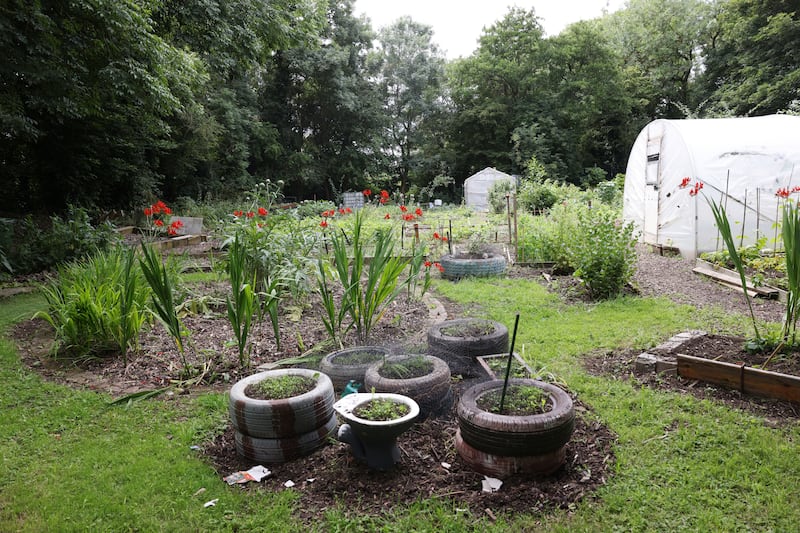
A voluntary, independent, inclusive group, CGI is very active and impressive, connecting community gardeners on the island of Ireland. It lobbies extensively, pointing out there’s no legal protection for community growing and local authorities have no duty to provide it if requested, or to use idle land temporarily. There’s no guidance for local authorities or landowners, no single department in charge of allotments and community gardens, no requirement for waiting lists. Its site cgireland.org has a very useful map of social community garden projects and allotments; the gaps are evident, but it’s handy for locating one nearby.
McCormack points out there’s no legislation or Government policy on growing your own food, nor on increasing or protecting community growing, an activity with multiple benefits for sustainability and biodiversity, food security, mental and physical health, and economically. In urban areas, land available for allotments and community gardens is becoming increasingly scarce. CGI’s submission this month to the Climate Action Plan 2024 Expert Evidence consultation calls for it to include community growing.
Its Let’s Get Growing report in March 2022 has specific, thought-through recommendations to improve the situation, including a target to double community growing spaces by 2025, waiting lists for local authorities, and improved legislation to provide protection and security of tenure to communities.
‘I cram in as much as I can ... It’s quiet, people come and go. And it’s great for recycling. I’m my own brown bin, I use cardboard for mulch. It’s very sustainable’
CGI proposes the current the draft Planning and Development Bill should require local authorities to reserve land for allotments and community gardens, and regulate, promote, facilitate, control, record demand and provide timely and affordable access to that land (with ministerial approval required for disposal or changing the use of local authority community growing spaces). Helping set up more community growing spaces, and additional protection for them, would be in line with European best practice, says CGI.
Kelly echoes that disparity across the State. It’s “very patchy and depends on whether you have an individual in the local authority, the climate officer or somebody else who’s interested and wants to make it happen. I think we need to get much better at providing these spaces for people if we want to encourage people to grow, and we should, because it has loads of really positive outcomes.”
That corner of the 120-hectare Corkagh Park is a productive one, a microcosm of different approaches to community growing. Over the river, about three minutes’ walk from Clondalkin Global Garden Community, are 39 council allotments.
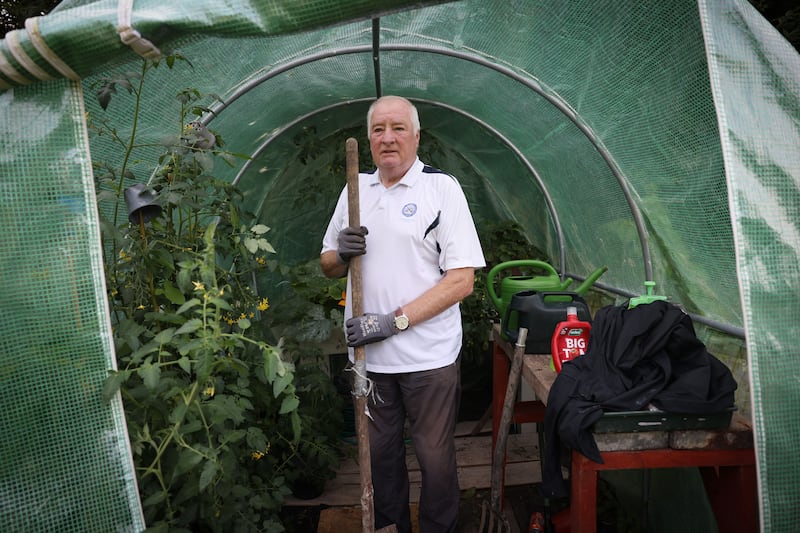
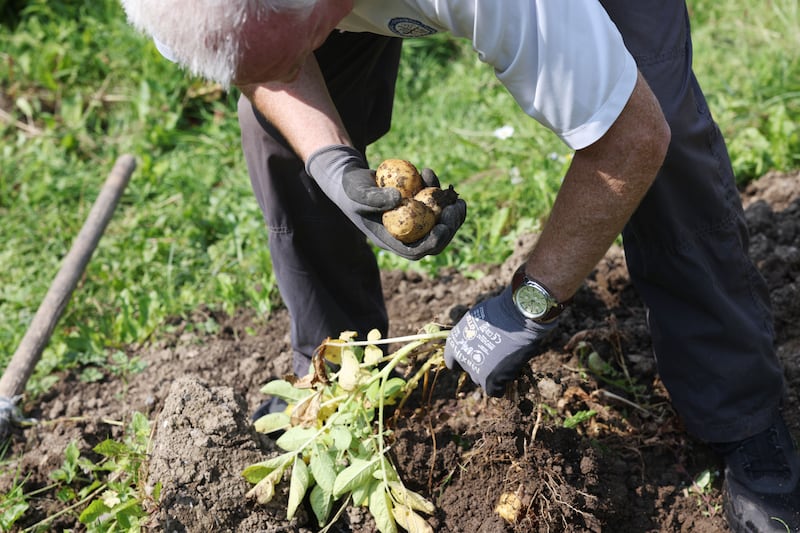

The large gate is locked but I catch Jimmy Walsh’s attention, where he’s working on his nephew’s allotment close by. He shows me around the large plot. Stop, he says suddenly, and points: “It’s a comma butterfly, they’re comparatively rare.” We watch it flutter between plants; I take a photo. He knows his butterflies, but he knows his birds better, and has put up nest boxes for bluetits.
We look at the thriving globe artichokes, nearly harvest-ready, and talk about what he’ll do with them. He cooks too, but he raves about his wife’s baking with the rhubarb. There are potatoes, peas (“lovely and sweet, they’re gorgeous”), apple trees bowed with fruit, and a small polytunnel with tomatoes. “That’s my wildlife spot,” he points to a corner with a butterfly bush (Buddleia), lavender, field scabious.
It’s a lot of work but Walsh, a retired bus driver, loves it. There’s a great mix of people in the allotments he says, probably the youngest in their 40s.
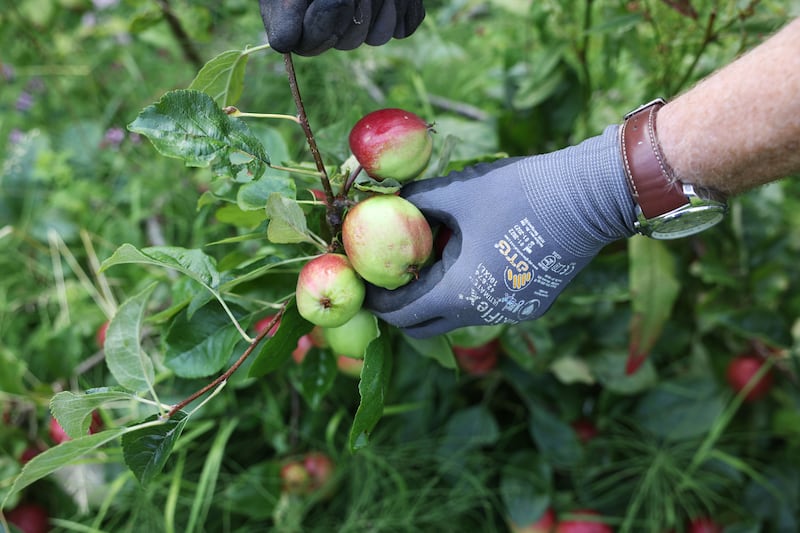
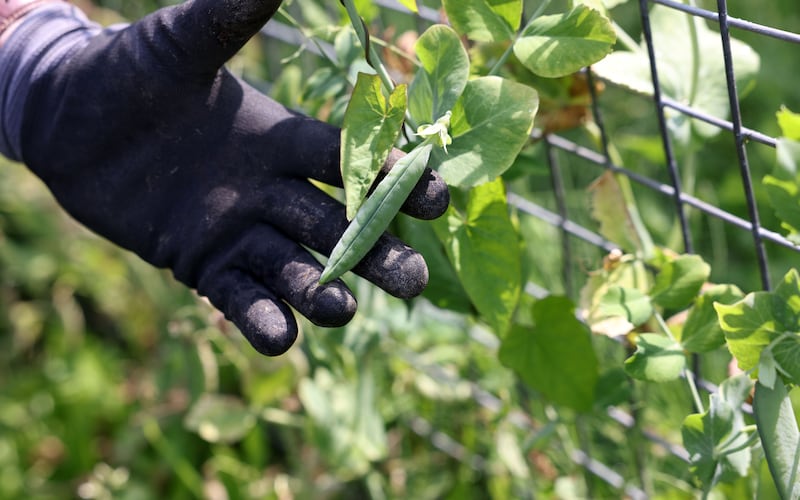
Walking down the path we run into Fridolin Kerr (her name is an Irish saint’s, she says), who lives seven minutes’ walk away. There’s a bit of chat about the allotment holders. She’s one of the best gardeners, says Walsh of Kerr. They agree that the allotment nearby of an Eastern European family “puts us all to shame”, including a pergola with roses. She recalls “a young lad in his 30s” getting an allotment. She makes a sceptical face, saying there was a bit of “We’ll see”. But “he keeps a lovely allotment. He’s stayed the course.”
Kerr has gardened there for four years, and was on the waiting list since 2011. “It was a lucky thing.” What does she grow? “Everything. I’m not a tidy gardener.” Pears, apples, plums, cherries, several kinds of berries. “The spuds are not great. That’s borage, it’s nice in ice-cubes. Asparagus, potatoes, garlic, courgettes, chives, thyme, rosemary.” There’s wildlife: grey squirrels, and foxes. The caterpillars like ragwort. She points out comfrey, “great for old remedies”, and “that’s meadowsweet, it’s wild. You can make wine with it.”
Originally from Clones in Monaghan, Kerr finds her allotment peaceful and restful, “down on my knees, hidden in the bushes. I come for 20 minutes then I look up and it’s been two hours.” She makes jams and chutneys and gives it all away. She used to get bags of horse manure from the equine centre, but now you can only get it in trailers.
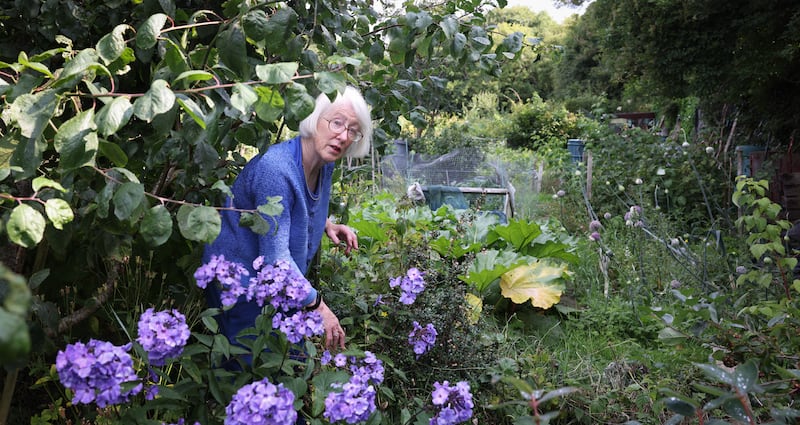

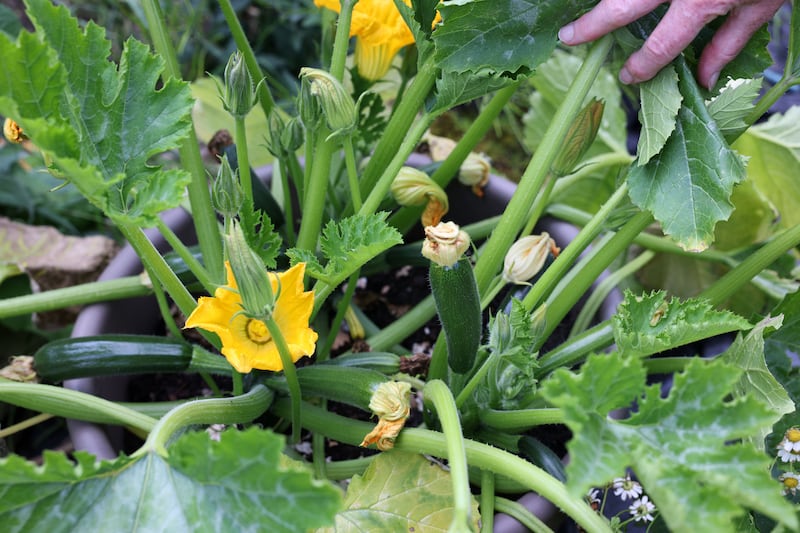
We run into Chris and Gertie Spring, arriving in their car with a wheelbarrow. They’ve had the allotment six years, and grow potatoes, onions, beetroot, rhubarb, horseradish, kale. The produce “goes 50/50, between the birds and us”. It’s food to eat, and food to give away.
Individuals rent allotments from the council, for €1 per square metre for the year, a very reasonable outlay of a couple of hundred euro, for the pleasure, the healthy activity, and plenty of organic fruit and vegetables. Those who don’t keep their allotment tended forfeit it and it’s allocated to another applicant. Thereby hangs the snag: There are not enough allotments for the demand in many areas of Ireland, with long waiting lists. Once you get an allotment, you may garden it for years.
In the UK there’s a legal duty on local authorities to provide allotments if there’s sufficient demand, but there’s no such obligation here, and it’s hit and miss in terms of provision.
[ This new Dublin allotment is a little piece of urban heavenOpens in new window ]
In the capital for instance, South Dublin County Council has 425 allotments of varying sizes at four locations, and there’s a waiting list. Fingal County Council manages an impressive 900 allotments at four locations, and allotment holders this year have to actively renew plots, with remaining plots reallocated by lottery. Dublin City Council warns all allotments are currently assigned “and it may be a matter of time before an allotment comes available”. In Dún Laoghaire Rathdown there are just 231 allotments, in two locations, and as of March 2023 it was not accepting applications because of the extensive waiting list.
Mick Kelly cautions that allotments are a big commitment. “They can be very large growing spaces, and sometimes people bite off more than they can chew. I have experience of that myself – digging up the whole back garden. That’s not necessarily a good plan when you’re starting off. It’s good to get a few years of experience under your belt and then think about an allotment if you need more space.”
But when it works out, the rewards can be great.
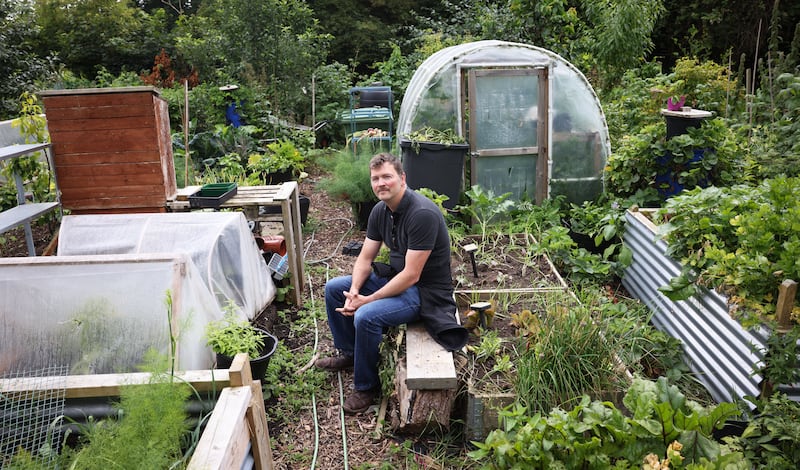

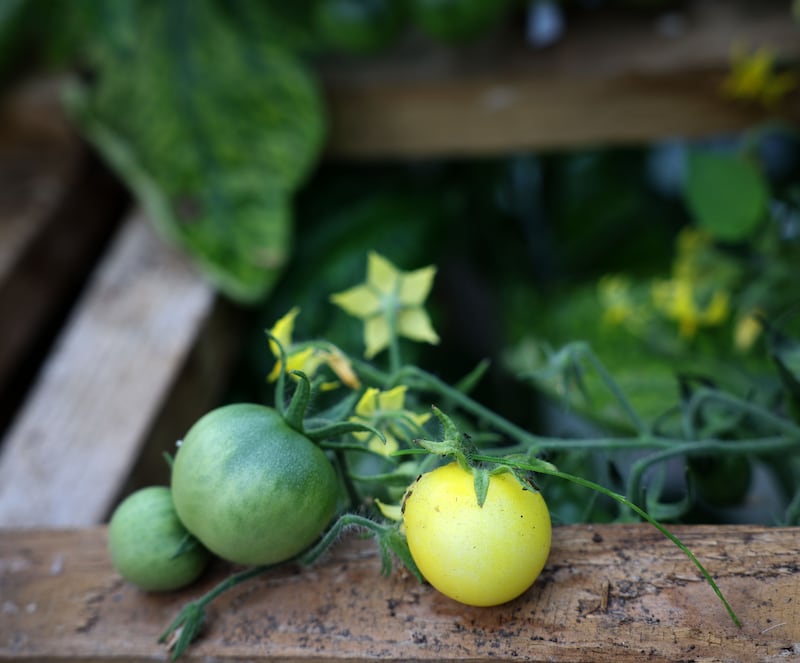

Near the entrance to the Corkagh Park allotments, Andrew Walker is shovelling soil into a barrow. He’s had his allotment for five or six years. He had his name on a few waiting lists for about six years, before this came up. He lives very close by, and works shifts, so he’s here most days: “a little every day”. He likes trying new stuff, learning the science behind growing, watching YouTube where “all the growers are talking about ‘no dig’ cultivation, leaving the worms to do all the work.” It works for some things he reckons, “but potatoes, you have to dig”. He gave up growing carrots because of carrot fly. He cooks “meat and two veg” but his wife Sandra is an expert and preserves a lot, making chutney, and also uses a dehydrator.
He has 200 sq m and “I cram in as much as I can. It’s perfect.” He loves the work. “The fresh air is good for the head. It’s quiet, people come and go. And it’s great for recycling. I’m my own brown bin, I use cardboard for mulch. It’s very sustainable.”




















